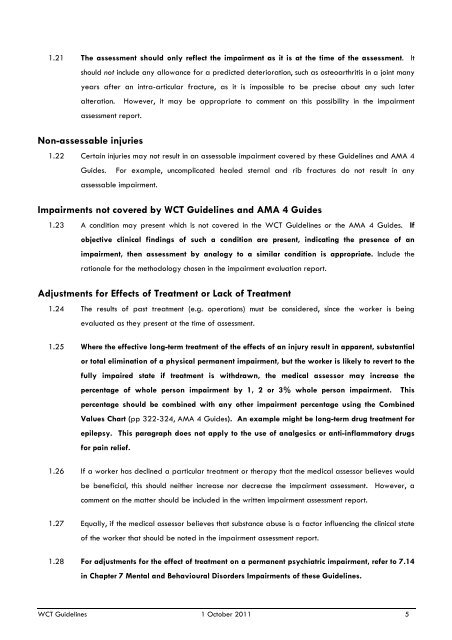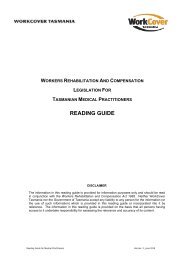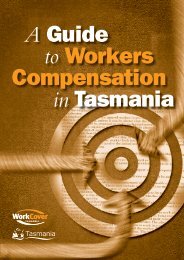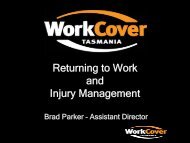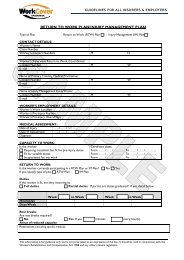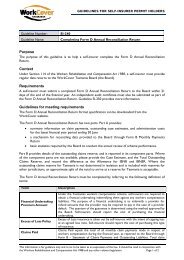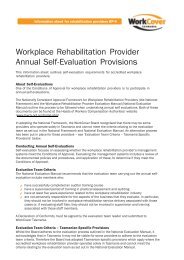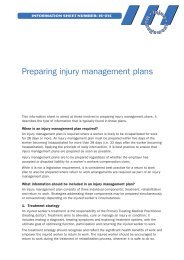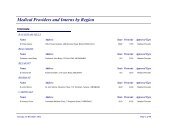Guidelines for the assessment of permanent impairment Version 3
Guidelines for the assessment of permanent impairment Version 3
Guidelines for the assessment of permanent impairment Version 3
You also want an ePaper? Increase the reach of your titles
YUMPU automatically turns print PDFs into web optimized ePapers that Google loves.
1.21 The <strong>assessment</strong> should only reflect <strong>the</strong> <strong>impairment</strong> as it is at <strong>the</strong> time <strong>of</strong> <strong>the</strong> <strong>assessment</strong>. Itshould not include any allowance <strong>for</strong> a predicted deterioration, such as osteoarthritis in a joint manyyears after an intra-articular fracture, as it is impossible to be precise about any such lateralteration. However, it may be appropriate to comment on this possibility in <strong>the</strong> <strong>impairment</strong><strong>assessment</strong> report.Non-assessable injuries1.22 Certain injuries may not result in an assessable <strong>impairment</strong> covered by <strong>the</strong>se <strong>Guidelines</strong> and AMA 4Guides. For example, uncomplicated healed sternal and rib fractures do not result in anyassessable <strong>impairment</strong>.Impairments not covered by WCT <strong>Guidelines</strong> and AMA 4 Guides1.23 A condition may present which is not covered in <strong>the</strong> WCT <strong>Guidelines</strong> or <strong>the</strong> AMA 4 Guides. Ifobjective clinical findings <strong>of</strong> such a condition are present, indicating <strong>the</strong> presence <strong>of</strong> an<strong>impairment</strong>, <strong>the</strong>n <strong>assessment</strong> by analogy to a similar condition is appropriate. Include <strong>the</strong>rationale <strong>for</strong> <strong>the</strong> methodology chosen in <strong>the</strong> <strong>impairment</strong> evaluation report.Adjustments <strong>for</strong> Effects <strong>of</strong> Treatment or Lack <strong>of</strong> Treatment1.24 The results <strong>of</strong> past treatment (e.g. operations) must be considered, since <strong>the</strong> worker is beingevaluated as <strong>the</strong>y present at <strong>the</strong> time <strong>of</strong> <strong>assessment</strong>.1.25 Where <strong>the</strong> effective long-term treatment <strong>of</strong> <strong>the</strong> effects <strong>of</strong> an injury result in apparent, substantialor total elimination <strong>of</strong> a physical <strong>permanent</strong> <strong>impairment</strong>, but <strong>the</strong> worker is likely to revert to <strong>the</strong>fully impaired state if treatment is withdrawn, <strong>the</strong> medical assessor may increase <strong>the</strong>percentage <strong>of</strong> whole person <strong>impairment</strong> by 1, 2 or 3% whole person <strong>impairment</strong>. Thispercentage should be combined with any o<strong>the</strong>r <strong>impairment</strong> percentage using <strong>the</strong> CombinedValues Chart (pp 322-324, AMA 4 Guides). An example might be long-term drug treatment <strong>for</strong>epilepsy. This paragraph does not apply to <strong>the</strong> use <strong>of</strong> analgesics or anti-inflammatory drugs<strong>for</strong> pain relief.1.26 If a worker has declined a particular treatment or <strong>the</strong>rapy that <strong>the</strong> medical assessor believes wouldbe beneficial, this should nei<strong>the</strong>r increase nor decrease <strong>the</strong> <strong>impairment</strong> <strong>assessment</strong>. However, acomment on <strong>the</strong> matter should be included in <strong>the</strong> written <strong>impairment</strong> <strong>assessment</strong> report.1.27 Equally, if <strong>the</strong> medical assessor believes that substance abuse is a factor influencing <strong>the</strong> clinical state<strong>of</strong> <strong>the</strong> worker that should be noted in <strong>the</strong> <strong>impairment</strong> <strong>assessment</strong> report.1.28 For adjustments <strong>for</strong> <strong>the</strong> effect <strong>of</strong> treatment on a <strong>permanent</strong> psychiatric <strong>impairment</strong>, refer to 7.14in Chapter 7 Mental and Behavioural Disorders Impairments <strong>of</strong> <strong>the</strong>se <strong>Guidelines</strong>.WCT <strong>Guidelines</strong> 1 October 2011 5


